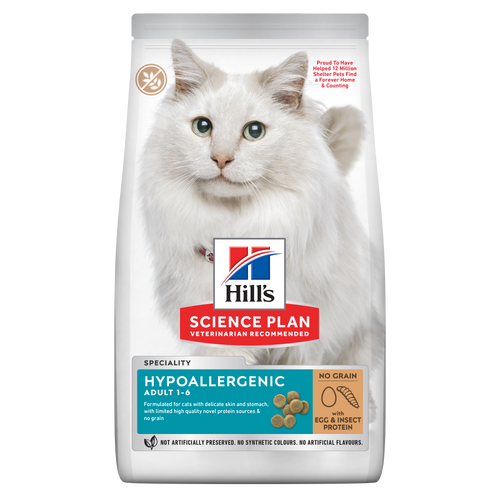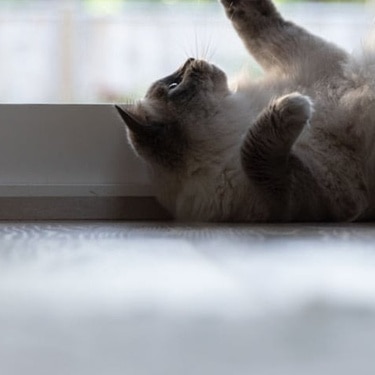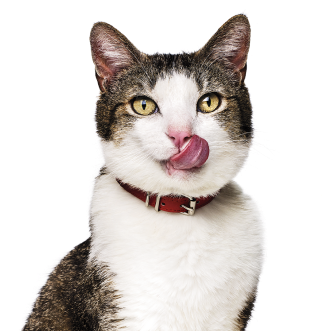
-
Finde das richtige Futter für dein TierFülle den Fragebogen aus und finde das passende Futter für deine vierbeinigen LieblingFinde das richtige Futter für dein TierFülle den Fragebogen aus und finde das passende Futter für deine vierbeinigen LieblingZugehörige Produkte
 Light Medium Mature Adult Hundefutter
Light Medium Mature Adult HundefutterHill’s Science Plan Light Mature Adult Medium Hundefutter mit Huhn ist ein Alleinfuttermittel, das speziell mit der ActivBiome+ Multi-Benefit-Technologie formuliert wurde.
Mit unserem kalorienarmen, wohlschmeckenden Futter bleibt dein Hund fit und aktiv.
Eine präzise Ernährung für weniger aktive ältere Hunde, die ein kalorienarmes Futter benötigen, das hilft, ein gesundes Gewicht zu halten.Jetzt einkaufen Small & Mini Mature Adult 7+ Hundefutter
Small & Mini Mature Adult 7+ HundefutterHill’s Science Plan Small & Mini Breed Mature Adult Hundefutter mit Huhn ist ein Alleinfuttermittel, das speziell mit der ActivBiome+ Multi-Benefit-Technologie formuliert wurde.
Maßgeschneiderte Ernährung zur Unterstützung eines gesunden Alterns bei kleinen Hunden. Speziell hergestellt mit einer synergetischen Mischung von Nährstoffen für Energie und Vitalität.Jetzt einkaufen Perfect Digestion Large Welpenfutter
Perfect Digestion Large WelpenfutterHill's Science Plan Perfect Digestion Large Breed Puppy Welpenfutter mit Huhn und braunem Reis versorgt das einzigartige Mikrobiom Ihres Welpen und hilft ihm, sein volles Potenzial auszuschöpfen.
Jetzt einkaufenHäufige DiagnosenZugehörige Produkte Hypoallergenic Trockenfutter für Katzen
Hypoallergenic Trockenfutter für KatzenHill's Science Plan Hypoallergenic Adult Katzenfutter mit Ei und Insektenprotein ist ein Alleinfuttermittel für erwachsene Katzen im Alter von 1-6 Jahren. Es wurde entwickelt für Katzen mit empfindlicher Haut und empfindlichem Magen, mit einer begrenzten Anzahl an hochwertigen, neuartigen Proteinquellen und ohne Getreide.
Jetzt einkaufen Hairball & Perfect Coat Katzenfutter Huhn
Hairball & Perfect Coat Katzenfutter HuhnHill`s Science Plan Hairball & Perfect Coat Adult Katzenfutter mit Huhn wurde entwickelt, um die Bildung von Haarballen bei erwachsenen Katzen wirksam zu verhindern und gleichzeitig ein schönes Fell zu fördern. Dank seiner Mischung aus essenziellen Omega-6-Fettsäuren ist dieses Futter gut für die Haut und das Fell der Katze und sorgt dafür, dass sie gesund und glänzend bleiben. Unsere Advanced Fibre Technology hilft, Haarballen zu reduzieren, indem sie deren Passage durch den Darm auf natürliche Weise fördert. Dieses Futter enthält hochwertige Proteine für eine perfekt ausgewogene, wohlschmeckende Rezeptur.
Jetzt einkaufen Light Adult Katzenfutter mit Huhn
Light Adult Katzenfutter mit HuhnZarte Stückchen Huhn in Soße für Katzen, mit L-Carnitin und weniger Kalorien für ein optimales Gewichtsmanagement. Voll an hochwertigem Protein, Omega-6-Fettsäuren und Vitamin E für glänzendes Fell und gesunde Haut.
Jetzt einkaufen -
Hund
- Tipps & Artikel zum Hund
-
Häufige Diagnosen Katze
- Gewicht
- Haut & Futtemittelempfindlichkeiten
- Harnwege
- Verdauung
- Gelenke
- Niere
- Genesung
- Zahnpflege
-
Lebensphasen - Hunde
- Ernährung von Welpen
- Ernährung von erwachsenen Hunden
- Ernährung von älteren Hunden
Katze- Tipps & Artikel zur Katze
-
Häufige Diagnosen Katze
- Gewicht
- Haut & Futtemittelempfindlichkeiten
- Harnwege
- Verdauung
- Niere
- Genesung
- Zahnpflege
- Stress
-
Lebensphasen - Katzen
- Ernährung von Kätzchen
- Ernährung von erwachsenen Katzen
- Ernährung von älteren Katzen
zugehörige Artikel Virtual Vet Visits: What You Need to Know
Virtual Vet Visits: What You Need to KnowLearn the ins and outs of a televet appointment before you talk to a vet online.
Mehr lesen Harnkristalle und -steine bei Hunden und Katzen
Harnkristalle und -steine bei Hunden und KatzenErfahre mehr über Ursachen und Behandlung von Harnkristallen bei Hunden und Katzen, um die Gesundheit deines Haustiers zu schützen. Ratschläge von Experten für die Unterstützung der unteren Harnwege finden Sie bei Hill's.
Mehr lesen Gewichtsveränderungen bei Hunden und Katzen - könnte es sich um Diabetes handeln?
Gewichtsveränderungen bei Hunden und Katzen - könnte es sich um Diabetes handeln?Diabetes ist eine Krankheit, bei der der Blutzuckerspiegel zu hoch ist. Es kann zu Gewichtszunahme oder -verlust bei Deiner Katze oder Deinem Hund führen.
Mehr lesen -

 Wissenschaftlich basierte Ernährung macht den Unterschied, dem du vertrauen kannst
Wissenschaftlich basierte Ernährung macht den Unterschied, dem du vertrauen kannst


Viele Menschen fragen sich, ob Katzen, genau wie Menschen, Harnwegsinfektionen und Blasenentzündungen bekommen können. Sie können in der Tat beides bekommen, allerdings sind Harnwegsinfektionen bei Katzen ziemlich selten.
Entzündung und Infektion sind zwei verschiedene Dinge. Eine Infektion wird durch Organismen wie Bakterien und Viren verursacht, die in einen oder mehrere Teile des Körpers eindringen. Das Vorhandensein dieser Organismen regt das Immunsystem des Körpers an, sie zu bekämpfen. Entzündungen sind die Reaktion des Körpers auf Verletzungen und Infektionen. Das entzündete Gewebe ist in der Regel rot und geschwollen und fühlt sich heiß an. Das liegt daran, dass der Körper Blut in den Bereich schickt, um die heilenden weißen Blutkörperchen, Blutplättchen und Blutgerinnungsfaktoren so schnell wie möglich dorthin zu bringen. Eine Infektion führt sicherlich zu einer Entzündung, aber eine Entzündung kann auch einfach durch ein Trauma, wie z. B. ein aufgeschürftes Knie, verursacht werden, ohne dass eine Infektion vorliegt.
Zystitis, also eine Blasenentzündung, ist in der Tat sehr häufig. Infektionen und andere häufigere Ursachen für Blasenentzündungen werden unter der Bezeichnung Feline Lower Urinary Tract Disease (FLUTD) zusammengefasst.
Wenn man versucht, FLUTD zu verstehen, ist es sehr nützlich zu wissen, wie sich Katzen entwickelt haben, und ihr natürliches Verhalten zu beobachten, wenn sie sich selbst überlassen sind. Katzen stammen von wüstenbewohnenden Katzen ab. Das bedeutet, dass sie sich so entwickelt haben, dass sie sehr gut Wasser sparen können und von Natur aus einen sehr konzentrierten Urin haben. Außerdem sind Katzen von Natur aus Einzelgänger, die ein großes Revier vor anderen Katzen bewachen, um ihre kostbaren Ressourcen an Nahrung und Wasser zu schützen. Für soziale Wesen wie den Menschen ist es manchmal schwer zu verstehen, dass manche Tiere lieber allein leben. Katzen neigen dazu, andere Katzen als Bedrohung zu betrachten und nicht als etwas, das sie in ihrem Revier willkommen heißen!
Was verursacht Blasenentzündungen bei Katzen?
Feline idiopathische Zystitis (FIC) ist die häufigste Ursache für FLUTD bei Katzen. Das Wort „idiopathisch“ bedeutet etwas, das ohne erkennbare Ursache auftritt. Die idiopathische Zystitis bei Katzen wird heute jedoch viel häufiger als Stresszystitis bezeichnet, da wir wissen, dass sie praktisch immer durch Stress verursacht wird.
Aber wie kann meine Katze gestresst sein, wenn sie den ganzen Tag nur schläft? Nun, Katzen sind sehr dezente Kommunikatoren und können Stress und Konflikte sehr gut verstecken. Manche Katzen tun sogar so, als ob sie schlafen würden, um Stresssituationen zu vermeiden, wie z. B. die Konfrontation mit einer anderen Katze im Haus, die sie schikanieren könnte.
Die Hauptursachen oder Auslöser einer Stressblasenentzündung sind:
Haushalte mit mehreren Katzen. Wenn Deine Katzen sich nicht gegenseitig putzen und nicht aneinander gekuschelt schlafen, sind sie wahrscheinlich keine guten Freunde. Katzen sind von Natur aus keine sozialen Wesen, und das Zusammenleben mit einer anderen Katze auf engem Raum kann eine große Stressquelle sein.
Katzen aus der Nachbarschaft. Auch wenn Du nur eine Katze hast, kann es sein, dass Du an einem Ort lebst, an dem es sehr viele Katzen gibt. Konflikte im Garten oder andere Katzen, die im Sommer durch die Katzenklappe oder offene Türen kommen, können sehr stressig sein.
Hauskatzen. Die ausschließliche Haltung in geschlossenen Räumen kann eine große Belastung darstellen. Katzen mögen ein großes Territorium und die Freiheit, es zu erkunden.
Besucher. Anfällige Katzen können sehr empfindlich auf Besucher reagieren, insbesondere auf Kinder, die Lärm machen oder versuchen, sie hochzuheben und zu streicheln.
Urlaub. Stress kann durch einen Aufenthalt im Tierheim oder auch nur durch den Urlaub der Besitzer ausgelöst werden.
Veränderungen des Hauses. Ein Umzug oder eine Renovierung Deines Hauses kann für manche Katzen, die sich an Vertrautheit und Routine erfreuen, ein leichter Auslöser sein.
Ein neues Baby. Die ungewohnten Gegenstände, Gerüche und Geräusche, die ein neues Baby mit sich bringt, sind auch für so sensible Tiere wie Katzen Auslöser.


Leckere Tipps
Kätzchen benötigen im ersten Jahr möglicherweise mehrere Impftermine. Erwachsene Katzen profitieren in der Regel von jährlichen Kontrolluntersuchungen, während ältere Katzen oder Katzen mit besonderen Bedürfnissen häufigere Besuche benötigen.
Warum verursacht Stress Blasenentzündungen?
Stress führt zur Freisetzung bestimmter Steroide, die kurzfristig nützlich sein können, aber bei chronischer Freisetzung das Immunsystem unterdrücken und eine Reihe von Körpersystemen negativ beeinflussen können. Katzen, die unter Stress leiden, können auch andere Anzeichen aufweisen, wie gelegentliche Magen-Darm-Beschwerden (z. B. Erbrechen und Durchfall). Sie können auch Haarausfall haben, weil sie sich zu sehr geputzt haben. Übermäßiges Putzen kann ein Verdrängungsverhalten sein, um Stress abzubauen, kann aber auch ein Zeichen für Schmerzen im Bauchraum sein, entweder durch eine Blasenentzündung oder durch Darmschmerzen. Viele gestresste Katzen haben kahle Flecken am Bauch und zwischen den Hinterbeinen.
Stress führt dazu, dass die Schutzschicht der Blase geschwächt und beschädigt wird, so dass der Urin mit dem empfindlichen Gewebe der Blasenwand in Kontakt kommt. Wie bereits erwähnt, neigen Katzen zu sehr konzentriertem Urin, der die Blase stark reizt, was zu Entzündungen führen kann. Entzündungszellen in der Blase können Gallengrieß oder Pfropfen bilden und den Urinabfluss blockieren. Dies ist ein medizinischer Notfall, denn bei einer Verstopfung der Blase kann es zu Nierenversagen oder einem Blasensprung kommen. Beide Ereignisse können schnell tödlich sein. Dies ist bei Katern aufgrund ihrer sehr engen Harnröhre viel häufiger der Fall.
Durch Stress verändert sich auch der pH-Wert des Urins. Wenn dies zunimmt, bilden sich bei einigen Katzen Struvitkristalle in der Blase, die zu Blasensteinen verklumpen können, was ein weiteres Risiko für eine Verstopfung darstellt. Ihr sehr konzentrierter Urin verstärkt sich diese Verklumpung noch, da die Mineralien, aus denen die Kristalle bestehen, in engem Kontakt stehen.
Andere Ursachen von FLUTD
Obwohl Stresszystitis die Hauptursache für FLUTD bei Katzen ist, gibt es auch andere Ursachen für die Erkrankung. Einige davon sind:
- Nierensteine und Harnkristalle und -steine. Kalziumoxalatkristalle können sich beispielsweise bilden, wenn Deine Katze eine hohe Kalziumkonzentration im Blut oder eine Nierenerkrankung hat. Ein hoher Uratspiegel kann die Folge einer Lebererkrankung sein und auch Blasensteine verursachen.
- Krebs in den Harnwegen kann Anzeichen einer Blasenentzündung hervorrufen.
- Harnwegsinfektion (UTI). Wie bereits eingangs erwähnt, sind Harnwegsinfektionen bei Katzen ziemlich selten. Ihr hochkonzentrierter Urin macht es Bakterien praktisch unmöglich, zu wachsen. Es kann jedoch vorkommen und ist bei älteren Katzen sehr viel häufiger der Fall. Der Grund dafür ist, dass ihr Urin bei nachlassender Nierenfunktion tendenziell verdünnt wird, was dazu führen kann, dass sich Bakterien festsetzen.
Anzeichen und Symptome von FLUTD
Du solltest eine Tierarztpraxis aufsuchen, wenn Du eines der folgenden Anzeichen bemerkst:
Blut im Urin oder eine rosa Färbung des Urins.
Strenger Harndrang, aber kein normaler Harnstrahl. Wenn Deine Katze keinen Urin absetzt, handelt es sich um einen medizinischen Notfall.
Vokalisieren/Jaulen beim Urinieren, was ein Zeichen für starke Beschwerden sein kann.
Verlust der Stubenreinheit oder unangemessenes Urinieren im Haus.
Erhöhte Häufigkeit des Wasserlassens.
Kieselhaltige Ablagerungen im hinteren Bereich.
Übermäßiges Putzen des Bauches.
Behandlung von FLUTD
Natürlich hängt dies zum Teil von der genauen Ursache ab. Deine Tierarztpraxis wird eine Urinprobe und Blutproben entnehmen und eventuell eine Röntgenaufnahme oder eine Ultraschalluntersuchung der Blase durchführen. Liegt eine Harnwegsinfektion vor, werden Antibiotika verschrieben. Die Behandlung und Vorbeugung von Rückfällen kann Folgendes umfassen:
- Vermehrte Wasseraufnahme. Dies ist bei allen Katzen mit Blasenproblemen sehr wichtig. Durch die Verdünnung des Urins wird die Blase weniger gereizt, und die Bildung von Kristallen wird wesentlich weniger wahrscheinlich. Wenn Deine Katze nicht viel trinkt, können Nassfutter mit Wasserzusatz oder eingeweichte Kroketten helfen. Trinkbrunnen und mehrere Wasserstationen sind ebenfalls hilfreich.
- Ernährung. Deine Tierarztpraxis kann eine therapeutische Diät empfehlen. Diese können je nach Art dazu beitragen, Steine und Kristalle aufzulösen, und haben einen veränderten Eiweiß- und Mineralstoffgehalt, um die Bausteine für Kristalle zu reduzieren. Außerdem enthalten sie einen hohen Anteil an Omega-Ölen aus Fisch, die Entzündungen hemmen, und Antioxidantien, die Zellschäden verhindern.
- Gewichtsabnahme und Bewegung. Übergewichtige Katzen sind viel anfälliger für FLUTD, so dass Deine Tierarztpraxis möglicherweise eine kombinierte Diät empfiehlt, um ihr Gewicht und ihre FLUTD zu behandeln. Bewegungsmangel kann zu Gewichtsproblemen beitragen und führt dazu, dass der Urin lange Zeit in der Blase bleibt. Die Förderung von Bewegung und Spiel kann wirklich helfen.
- Eine Operation. Deine Tierarztpraxis muss Deine Katze möglicherweise sedieren, um die Harnwege chirurgisch freizulegen oder Kalziumoxalatsteine zu entfernen. Darauf folgt in der Regel eine spezielle Ernährung, um ein erneutes Auftreten zu verhindern.
- Wiederholung der Urinprobe. Deine Tierarztpraxis muss Deine Katze überwachen, um sicherzustellen, dass die Blasenentzündung abgeklungen ist und sich etwaige Steine aufgelöst haben. Dazu sind wiederholte Urinproben und möglicherweise eine Bildgebung erforderlich.
- Umgang mit Stress in der Umwelt. Der schicke Ausdruck dafür ist Multi-Modal Umweltmodifikation (MMEM), aber es bedeutet einfach, den Stress zu Hause zu reduzieren. Dies kannst du wie folgt bewerkstelligen:
Gib Deiner Katze, wenn möglich, eine Möglichkeit nach draußen zu gelangen.
Mehrere Futter- und Wasserstationen an ruhigen, separaten Orten im Haus aufstellen, damit es nie zu Konflikten um Futter oder Wasser kommt. Du brauchst jeweils eine mehr, als Du Katzen hast.
Aufstellen mehrerer Katzentoiletten an anderen ruhigen Orten. Auch hier gilt: eine mehr als die Anzahl der Katzen. Biete Katzentoiletten an, auch wenn Du eine Katzenklappe hast.
Aufstellen von Möbeln und Regalen in Gängen, in denen Deine Katzen aneinander vorbeigehen müssen. So können sie sich auf verschiedenen Ebenen frei und ohne Konflikte bewegen.
Verwende Pheromone, damit sich Deine Katzen entspannter fühlen.
FLUTD ist ein komplexes Leiden, aber mit schnellem Eingreifen und guter Teamarbeit kann Deine Katze einen guten Ausgang haben und hoffentlich nie wieder erkranken. Wie bei den meisten Dingen gilt: Vorbeugen ist besser als heilen. Überlege Dir gut, ob Du mehrere Katzen halten willst, und wenn ja, sprich mit Deinem Tierarzt oder Deiner Tierärztin oder befolge die oben genannten Tipps, um das Haus von Anfang an so harmonisch und stressfrei wie möglich zu halten. Wenn Du Stress für Deine Katze vermeidest, wird auch Dein Leben viel stressfreier!
Überprüft von Dr. Hein Meyer, DVM, PhD, Dipl-ECVIM-CA und Dr. Emma Milne BVSc FRCVS


Einer unserer Autoren hat diesen Artikel für Sie verfasst
Produkte für Katzen mit Nierenproblemen

Hill's Science Plan Hypoallergenic Adult Katzenfutter mit Ei und Insektenprotein ist ein Alleinfuttermittel für erwachsene Katzen im Alter von 1-6 Jahren. Es wurde entwickelt für Katzen mit empfindlicher Haut und empfindlichem Magen, mit einer begrenzten Anzahl an hochwertigen, neuartigen Proteinquellen und ohne Getreide.

Exakt ausgewogene Ernährung in zwei köstlichen Geschmacksrichtungen, die hilft, die Alterungserscheinungen bei älteren Katzen zu bekämpfen

Zarte Stückchen Huhn in Soße für Katzen, mit L-Carnitin und weniger Kalorien für ein optimales Gewichtsmanagement. Voll an hochwertigem Protein, Omega-6-Fettsäuren und Vitamin E für glänzendes Fell und gesunde Haut.

Hill`s Science Plan Hairball & Perfect Coat Adult Katzenfutter mit Huhn wurde entwickelt, um die Bildung von Haarballen bei erwachsenen Katzen wirksam zu verhindern und gleichzeitig ein schönes Fell zu fördern. Dank seiner Mischung aus essenziellen Omega-6-Fettsäuren ist dieses Futter gut für die Haut und das Fell der Katze und sorgt dafür, dass sie gesund und glänzend bleiben. Unsere Advanced Fibre Technology hilft, Haarballen zu reduzieren, indem sie deren Passage durch den Darm auf natürliche Weise fördert. Dieses Futter enthält hochwertige Proteine für eine perfekt ausgewogene, wohlschmeckende Rezeptur.
Weiterführende Artikel

Entdecke, was Du tun kannst, um einen empfindlichen Katzenmagen zu erkennen und zu unterstützen. Finde heraus, welche Routinen und welches Futter Du einsetzen kannst, damit Deine Katze glücklich und gesund ist.

Die Fütterungszeit kann eine wunderbare Gelegenheit sein, eine Bindung zwischen Dir und Deiner Katze herzustellen. Finde heraus, wie Du das Beste daraus machen und mit Hill's eine gesunde Gewohnheit schaffen kannst.

Nassfutter für Katzen kann ein wahrer Genuss für die Geschmacksnerven Deines Tieres sein und ist eine gute Wahl für wählerische Fresser. Erfahre, wie viel Futter Du füttern solltest mit Hill's Pet.

Erfahre, wie Du die Verdauung Deiner Katze unterstützen kannst, um ihre allgemeine Gesundheit zu fördern. Die Ernährung ist der Schlüssel für ein langes und glückliches Leben Deiner Katze, also finde heraus, was Du tun kannst.

Setze deine Katze auf Diät, ohne dass sie es merkt
Unsere kalorienarme Formel hilft, das Gewicht deiner Katze zu kontrollieren. Sie enthält hochwertiges Protein für den Muskelaufbau und ist mit gezielt ausgewählten Zutaten für eine schmackhafte, nahrhafte Mahlzeit zubereitet. Klinisch erprobte Antioxidantien sowie Vitamin C und E fördern ein gesundes Immunsystem.
Setze deine Katze auf Diät, ohne dass sie es merkt
Unsere kalorienarme Formel hilft, das Gewicht deiner Katze zu kontrollieren. Sie enthält hochwertiges Protein für den Muskelaufbau und ist mit gezielt ausgewählten Zutaten für eine schmackhafte, nahrhafte Mahlzeit zubereitet. Klinisch erprobte Antioxidantien sowie Vitamin C und E fördern ein gesundes Immunsystem.